PROJ 6008: Case Study of J & J Furnishings: Contemporary Leadership
VerifiedAdded on 2023/05/28
|9
|2386
|471
Case Study
AI Summary
This case study analyzes the leadership practices of J & J Furnishings, a furniture company expanding globally. The assignment explores key principles of strategic human resource management, emphasizing their impact on organizational performance, ethics, and the relationship between effective people management and company success. It examines different approaches to managing teams in a global environment, including creating missions, defining roles, building trust, and leveraging opportunities. The analysis highlights transformational leadership as a key element, discussing the tools and techniques used to influence project teams, such as clearly defined purposes, interpersonal skills, training, and rewards. The study also identifies the types of power employed and the steps taken to alleviate challenges faced by project teams, referencing the case study of J & J Furnishings and its implementation of transformational leadership. This assignment provides a comprehensive overview of leadership strategies, team dynamics, and their application within a real-world business context.
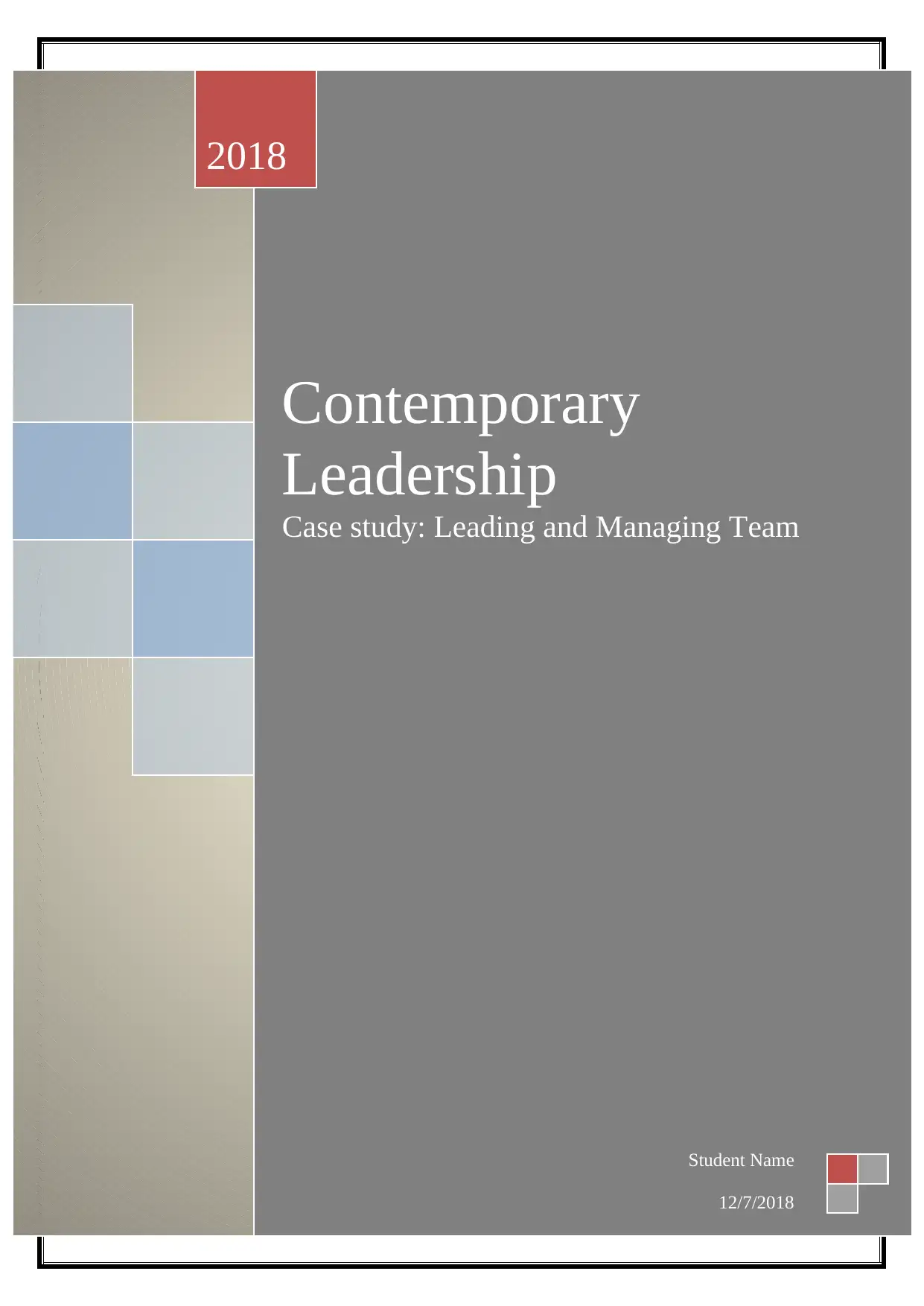
Contemporary
Leadership
Case study: Leading and Managing Team
2018
Student Name
12/7/2018
Leadership
Case study: Leading and Managing Team
2018
Student Name
12/7/2018
Paraphrase This Document
Need a fresh take? Get an instant paraphrase of this document with our AI Paraphraser
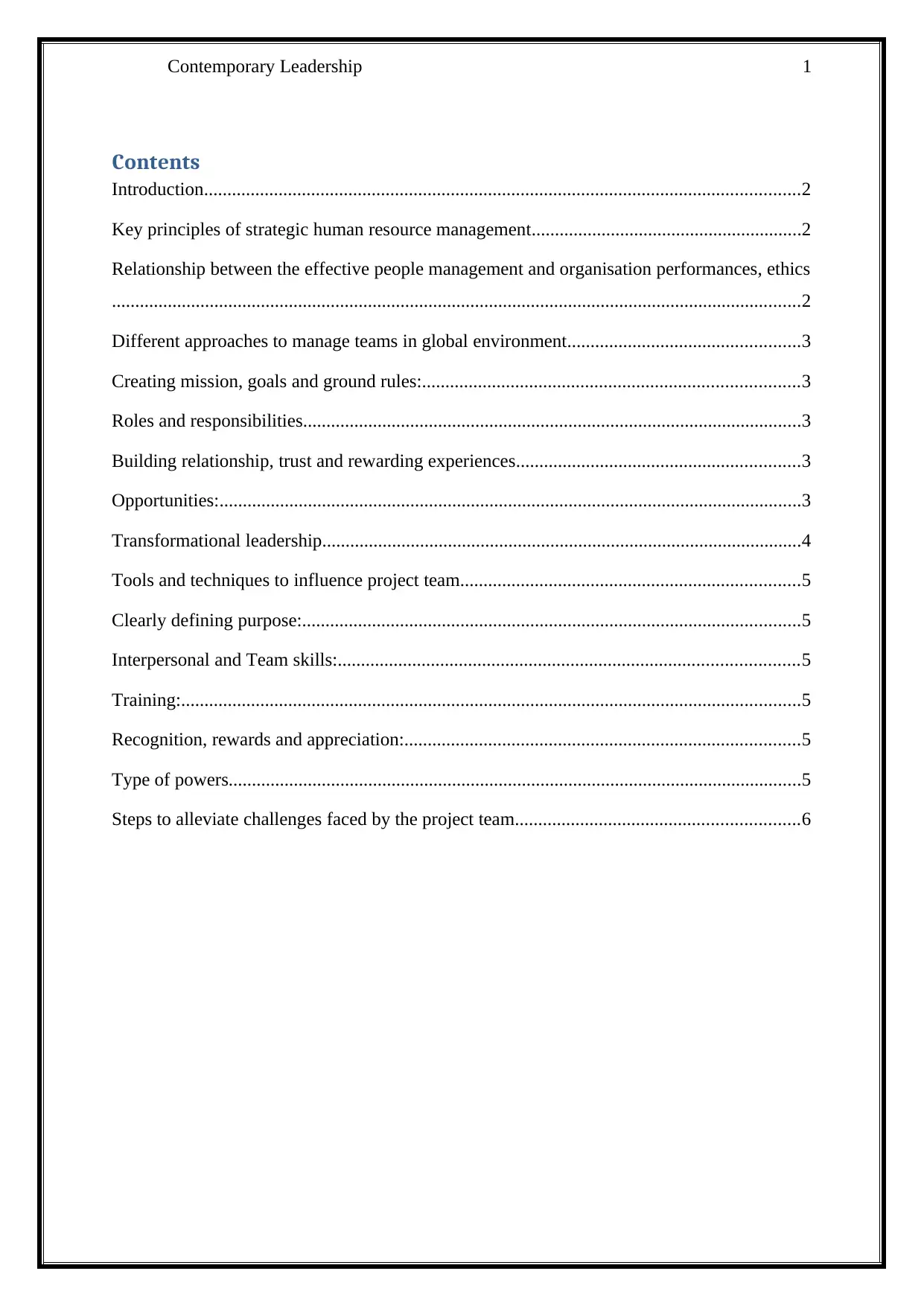
Contemporary Leadership 1
Contents
Introduction................................................................................................................................2
Key principles of strategic human resource management..........................................................2
Relationship between the effective people management and organisation performances, ethics
....................................................................................................................................................2
Different approaches to manage teams in global environment..................................................3
Creating mission, goals and ground rules:.................................................................................3
Roles and responsibilities...........................................................................................................3
Building relationship, trust and rewarding experiences.............................................................3
Opportunities:.............................................................................................................................3
Transformational leadership.......................................................................................................4
Tools and techniques to influence project team.........................................................................5
Clearly defining purpose:...........................................................................................................5
Interpersonal and Team skills:...................................................................................................5
Training:.....................................................................................................................................5
Recognition, rewards and appreciation:.....................................................................................5
Type of powers...........................................................................................................................5
Steps to alleviate challenges faced by the project team.............................................................6
Contents
Introduction................................................................................................................................2
Key principles of strategic human resource management..........................................................2
Relationship between the effective people management and organisation performances, ethics
....................................................................................................................................................2
Different approaches to manage teams in global environment..................................................3
Creating mission, goals and ground rules:.................................................................................3
Roles and responsibilities...........................................................................................................3
Building relationship, trust and rewarding experiences.............................................................3
Opportunities:.............................................................................................................................3
Transformational leadership.......................................................................................................4
Tools and techniques to influence project team.........................................................................5
Clearly defining purpose:...........................................................................................................5
Interpersonal and Team skills:...................................................................................................5
Training:.....................................................................................................................................5
Recognition, rewards and appreciation:.....................................................................................5
Type of powers...........................................................................................................................5
Steps to alleviate challenges faced by the project team.............................................................6
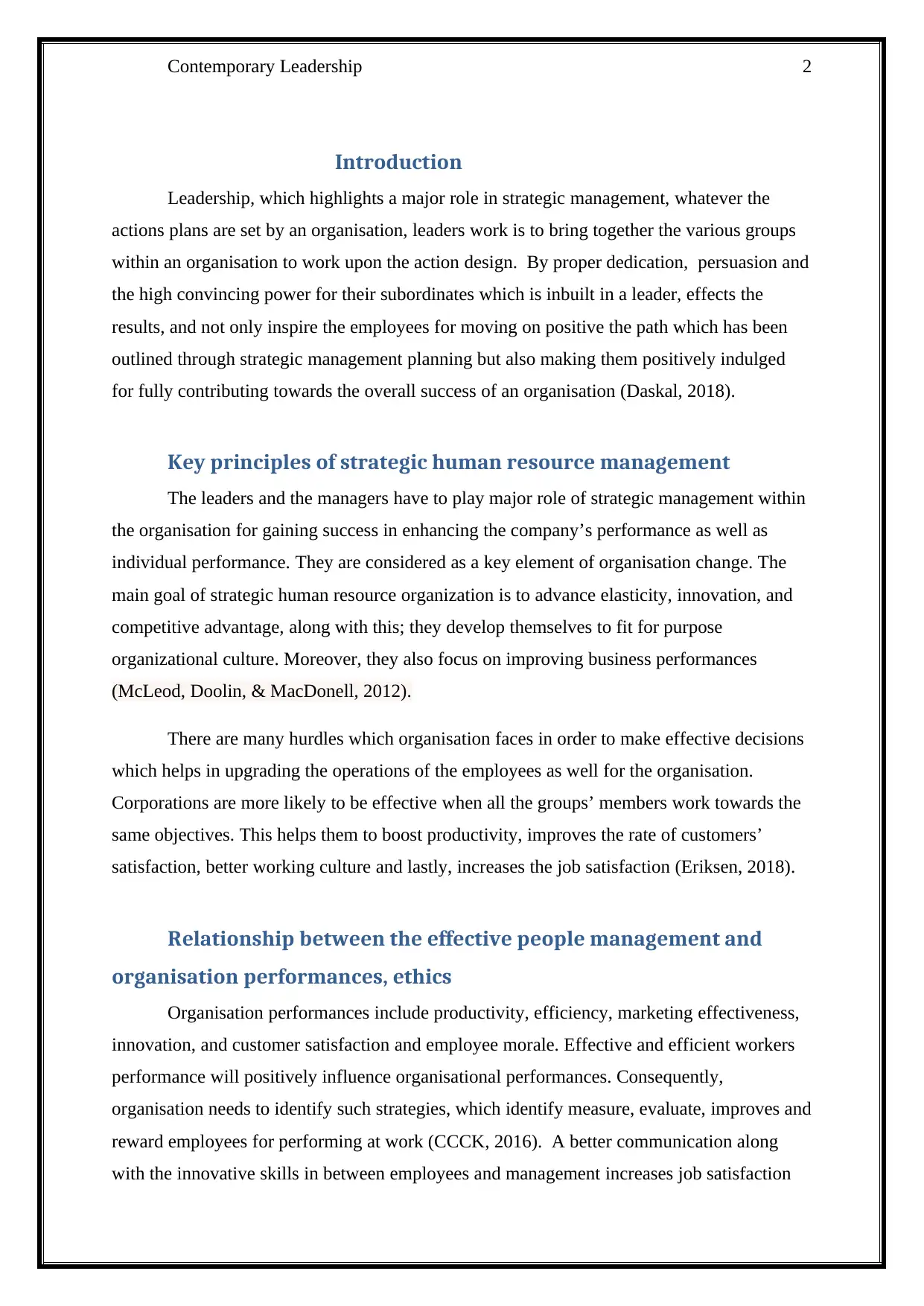
Contemporary Leadership 2
Introduction
Leadership, which highlights a major role in strategic management, whatever the
actions plans are set by an organisation, leaders work is to bring together the various groups
within an organisation to work upon the action design. By proper dedication, persuasion and
the high convincing power for their subordinates which is inbuilt in a leader, effects the
results, and not only inspire the employees for moving on positive the path which has been
outlined through strategic management planning but also making them positively indulged
for fully contributing towards the overall success of an organisation (Daskal, 2018).
Key principles of strategic human resource management
The leaders and the managers have to play major role of strategic management within
the organisation for gaining success in enhancing the company’s performance as well as
individual performance. They are considered as a key element of organisation change. The
main goal of strategic human resource organization is to advance elasticity, innovation, and
competitive advantage, along with this; they develop themselves to fit for purpose
organizational culture. Moreover, they also focus on improving business performances
(McLeod, Doolin, & MacDonell, 2012).
There are many hurdles which organisation faces in order to make effective decisions
which helps in upgrading the operations of the employees as well for the organisation.
Corporations are more likely to be effective when all the groups’ members work towards the
same objectives. This helps them to boost productivity, improves the rate of customers’
satisfaction, better working culture and lastly, increases the job satisfaction (Eriksen, 2018).
Relationship between the effective people management and
organisation performances, ethics
Organisation performances include productivity, efficiency, marketing effectiveness,
innovation, and customer satisfaction and employee morale. Effective and efficient workers
performance will positively influence organisational performances. Consequently,
organisation needs to identify such strategies, which identify measure, evaluate, improves and
reward employees for performing at work (CCCK, 2016). A better communication along
with the innovative skills in between employees and management increases job satisfaction
Introduction
Leadership, which highlights a major role in strategic management, whatever the
actions plans are set by an organisation, leaders work is to bring together the various groups
within an organisation to work upon the action design. By proper dedication, persuasion and
the high convincing power for their subordinates which is inbuilt in a leader, effects the
results, and not only inspire the employees for moving on positive the path which has been
outlined through strategic management planning but also making them positively indulged
for fully contributing towards the overall success of an organisation (Daskal, 2018).
Key principles of strategic human resource management
The leaders and the managers have to play major role of strategic management within
the organisation for gaining success in enhancing the company’s performance as well as
individual performance. They are considered as a key element of organisation change. The
main goal of strategic human resource organization is to advance elasticity, innovation, and
competitive advantage, along with this; they develop themselves to fit for purpose
organizational culture. Moreover, they also focus on improving business performances
(McLeod, Doolin, & MacDonell, 2012).
There are many hurdles which organisation faces in order to make effective decisions
which helps in upgrading the operations of the employees as well for the organisation.
Corporations are more likely to be effective when all the groups’ members work towards the
same objectives. This helps them to boost productivity, improves the rate of customers’
satisfaction, better working culture and lastly, increases the job satisfaction (Eriksen, 2018).
Relationship between the effective people management and
organisation performances, ethics
Organisation performances include productivity, efficiency, marketing effectiveness,
innovation, and customer satisfaction and employee morale. Effective and efficient workers
performance will positively influence organisational performances. Consequently,
organisation needs to identify such strategies, which identify measure, evaluate, improves and
reward employees for performing at work (CCCK, 2016). A better communication along
with the innovative skills in between employees and management increases job satisfaction
⊘ This is a preview!⊘
Do you want full access?
Subscribe today to unlock all pages.

Trusted by 1+ million students worldwide
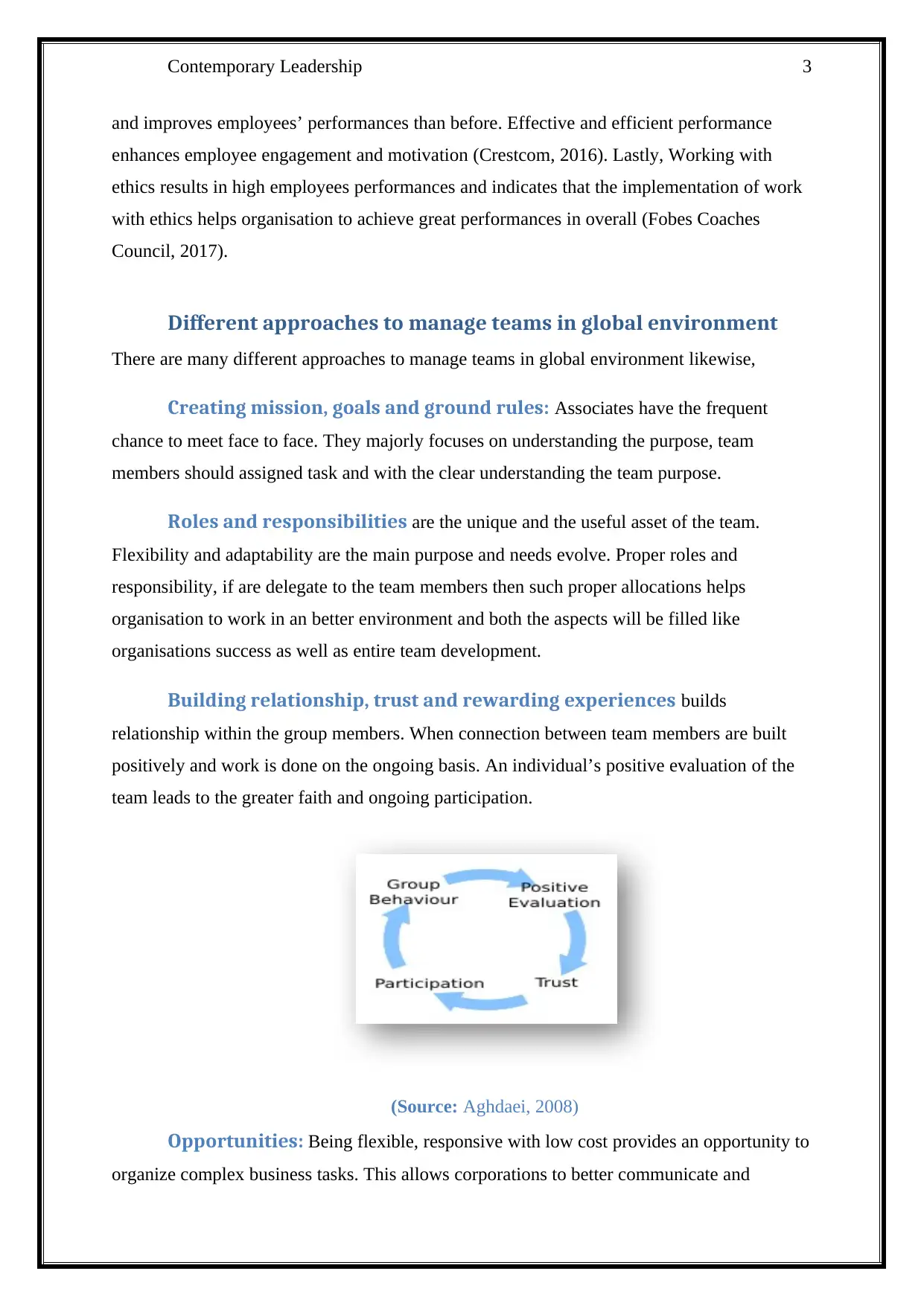
Contemporary Leadership 3
and improves employees’ performances than before. Effective and efficient performance
enhances employee engagement and motivation (Crestcom, 2016). Lastly, Working with
ethics results in high employees performances and indicates that the implementation of work
with ethics helps organisation to achieve great performances in overall (Fobes Coaches
Council, 2017).
Different approaches to manage teams in global environment
There are many different approaches to manage teams in global environment likewise,
Creating mission, goals and ground rules: Associates have the frequent
chance to meet face to face. They majorly focuses on understanding the purpose, team
members should assigned task and with the clear understanding the team purpose.
Roles and responsibilities are the unique and the useful asset of the team.
Flexibility and adaptability are the main purpose and needs evolve. Proper roles and
responsibility, if are delegate to the team members then such proper allocations helps
organisation to work in an better environment and both the aspects will be filled like
organisations success as well as entire team development.
Building relationship, trust and rewarding experiences builds
relationship within the group members. When connection between team members are built
positively and work is done on the ongoing basis. An individual’s positive evaluation of the
team leads to the greater faith and ongoing participation.
(Source: Aghdaei, 2008)
Opportunities: Being flexible, responsive with low cost provides an opportunity to
organize complex business tasks. This allows corporations to better communicate and
and improves employees’ performances than before. Effective and efficient performance
enhances employee engagement and motivation (Crestcom, 2016). Lastly, Working with
ethics results in high employees performances and indicates that the implementation of work
with ethics helps organisation to achieve great performances in overall (Fobes Coaches
Council, 2017).
Different approaches to manage teams in global environment
There are many different approaches to manage teams in global environment likewise,
Creating mission, goals and ground rules: Associates have the frequent
chance to meet face to face. They majorly focuses on understanding the purpose, team
members should assigned task and with the clear understanding the team purpose.
Roles and responsibilities are the unique and the useful asset of the team.
Flexibility and adaptability are the main purpose and needs evolve. Proper roles and
responsibility, if are delegate to the team members then such proper allocations helps
organisation to work in an better environment and both the aspects will be filled like
organisations success as well as entire team development.
Building relationship, trust and rewarding experiences builds
relationship within the group members. When connection between team members are built
positively and work is done on the ongoing basis. An individual’s positive evaluation of the
team leads to the greater faith and ongoing participation.
(Source: Aghdaei, 2008)
Opportunities: Being flexible, responsive with low cost provides an opportunity to
organize complex business tasks. This allows corporations to better communicate and
Paraphrase This Document
Need a fresh take? Get an instant paraphrase of this document with our AI Paraphraser
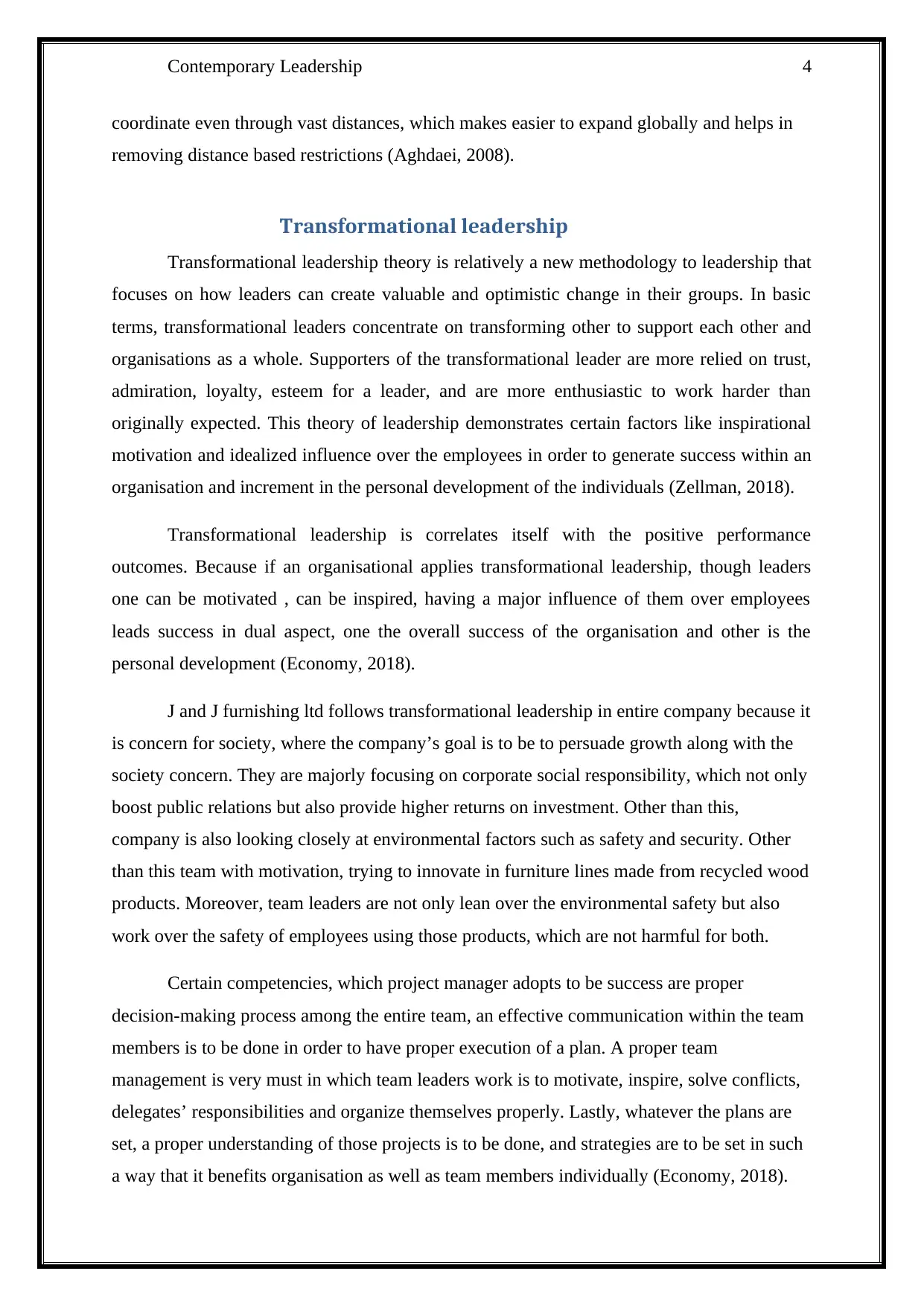
Contemporary Leadership 4
coordinate even through vast distances, which makes easier to expand globally and helps in
removing distance based restrictions (Aghdaei, 2008).
Transformational leadership
Transformational leadership theory is relatively a new methodology to leadership that
focuses on how leaders can create valuable and optimistic change in their groups. In basic
terms, transformational leaders concentrate on transforming other to support each other and
organisations as a whole. Supporters of the transformational leader are more relied on trust,
admiration, loyalty, esteem for a leader, and are more enthusiastic to work harder than
originally expected. This theory of leadership demonstrates certain factors like inspirational
motivation and idealized influence over the employees in order to generate success within an
organisation and increment in the personal development of the individuals (Zellman, 2018).
Transformational leadership is correlates itself with the positive performance
outcomes. Because if an organisational applies transformational leadership, though leaders
one can be motivated , can be inspired, having a major influence of them over employees
leads success in dual aspect, one the overall success of the organisation and other is the
personal development (Economy, 2018).
J and J furnishing ltd follows transformational leadership in entire company because it
is concern for society, where the company’s goal is to be to persuade growth along with the
society concern. They are majorly focusing on corporate social responsibility, which not only
boost public relations but also provide higher returns on investment. Other than this,
company is also looking closely at environmental factors such as safety and security. Other
than this team with motivation, trying to innovate in furniture lines made from recycled wood
products. Moreover, team leaders are not only lean over the environmental safety but also
work over the safety of employees using those products, which are not harmful for both.
Certain competencies, which project manager adopts to be success are proper
decision-making process among the entire team, an effective communication within the team
members is to be done in order to have proper execution of a plan. A proper team
management is very must in which team leaders work is to motivate, inspire, solve conflicts,
delegates’ responsibilities and organize themselves properly. Lastly, whatever the plans are
set, a proper understanding of those projects is to be done, and strategies are to be set in such
a way that it benefits organisation as well as team members individually (Economy, 2018).
coordinate even through vast distances, which makes easier to expand globally and helps in
removing distance based restrictions (Aghdaei, 2008).
Transformational leadership
Transformational leadership theory is relatively a new methodology to leadership that
focuses on how leaders can create valuable and optimistic change in their groups. In basic
terms, transformational leaders concentrate on transforming other to support each other and
organisations as a whole. Supporters of the transformational leader are more relied on trust,
admiration, loyalty, esteem for a leader, and are more enthusiastic to work harder than
originally expected. This theory of leadership demonstrates certain factors like inspirational
motivation and idealized influence over the employees in order to generate success within an
organisation and increment in the personal development of the individuals (Zellman, 2018).
Transformational leadership is correlates itself with the positive performance
outcomes. Because if an organisational applies transformational leadership, though leaders
one can be motivated , can be inspired, having a major influence of them over employees
leads success in dual aspect, one the overall success of the organisation and other is the
personal development (Economy, 2018).
J and J furnishing ltd follows transformational leadership in entire company because it
is concern for society, where the company’s goal is to be to persuade growth along with the
society concern. They are majorly focusing on corporate social responsibility, which not only
boost public relations but also provide higher returns on investment. Other than this,
company is also looking closely at environmental factors such as safety and security. Other
than this team with motivation, trying to innovate in furniture lines made from recycled wood
products. Moreover, team leaders are not only lean over the environmental safety but also
work over the safety of employees using those products, which are not harmful for both.
Certain competencies, which project manager adopts to be success are proper
decision-making process among the entire team, an effective communication within the team
members is to be done in order to have proper execution of a plan. A proper team
management is very must in which team leaders work is to motivate, inspire, solve conflicts,
delegates’ responsibilities and organize themselves properly. Lastly, whatever the plans are
set, a proper understanding of those projects is to be done, and strategies are to be set in such
a way that it benefits organisation as well as team members individually (Economy, 2018).
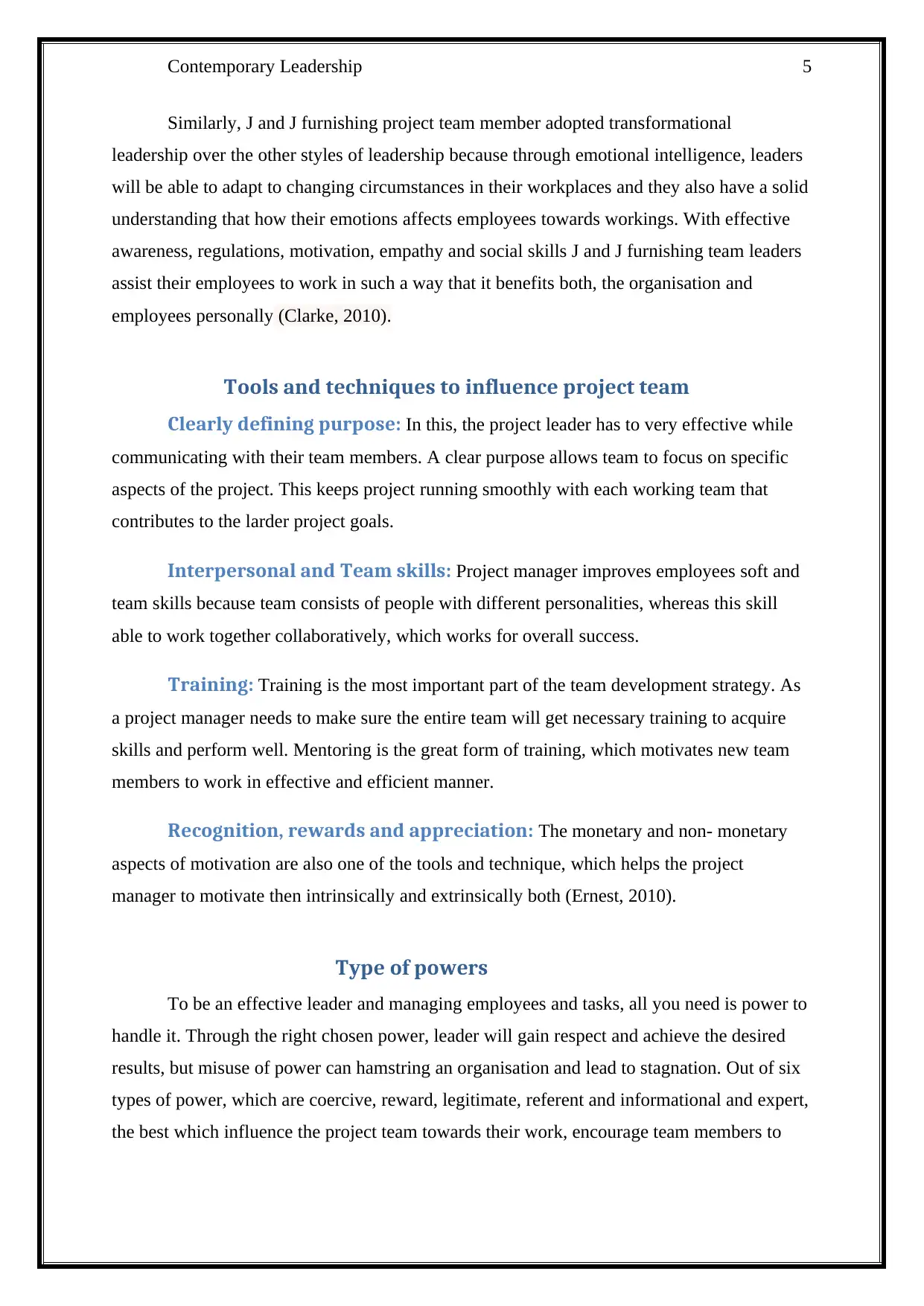
Contemporary Leadership 5
Similarly, J and J furnishing project team member adopted transformational
leadership over the other styles of leadership because through emotional intelligence, leaders
will be able to adapt to changing circumstances in their workplaces and they also have a solid
understanding that how their emotions affects employees towards workings. With effective
awareness, regulations, motivation, empathy and social skills J and J furnishing team leaders
assist their employees to work in such a way that it benefits both, the organisation and
employees personally (Clarke, 2010).
Tools and techniques to influence project team
Clearly defining purpose: In this, the project leader has to very effective while
communicating with their team members. A clear purpose allows team to focus on specific
aspects of the project. This keeps project running smoothly with each working team that
contributes to the larder project goals.
Interpersonal and Team skills: Project manager improves employees soft and
team skills because team consists of people with different personalities, whereas this skill
able to work together collaboratively, which works for overall success.
Training: Training is the most important part of the team development strategy. As
a project manager needs to make sure the entire team will get necessary training to acquire
skills and perform well. Mentoring is the great form of training, which motivates new team
members to work in effective and efficient manner.
Recognition, rewards and appreciation: The monetary and non- monetary
aspects of motivation are also one of the tools and technique, which helps the project
manager to motivate then intrinsically and extrinsically both (Ernest, 2010).
Type of powers
To be an effective leader and managing employees and tasks, all you need is power to
handle it. Through the right chosen power, leader will gain respect and achieve the desired
results, but misuse of power can hamstring an organisation and lead to stagnation. Out of six
types of power, which are coercive, reward, legitimate, referent and informational and expert,
the best which influence the project team towards their work, encourage team members to
Similarly, J and J furnishing project team member adopted transformational
leadership over the other styles of leadership because through emotional intelligence, leaders
will be able to adapt to changing circumstances in their workplaces and they also have a solid
understanding that how their emotions affects employees towards workings. With effective
awareness, regulations, motivation, empathy and social skills J and J furnishing team leaders
assist their employees to work in such a way that it benefits both, the organisation and
employees personally (Clarke, 2010).
Tools and techniques to influence project team
Clearly defining purpose: In this, the project leader has to very effective while
communicating with their team members. A clear purpose allows team to focus on specific
aspects of the project. This keeps project running smoothly with each working team that
contributes to the larder project goals.
Interpersonal and Team skills: Project manager improves employees soft and
team skills because team consists of people with different personalities, whereas this skill
able to work together collaboratively, which works for overall success.
Training: Training is the most important part of the team development strategy. As
a project manager needs to make sure the entire team will get necessary training to acquire
skills and perform well. Mentoring is the great form of training, which motivates new team
members to work in effective and efficient manner.
Recognition, rewards and appreciation: The monetary and non- monetary
aspects of motivation are also one of the tools and technique, which helps the project
manager to motivate then intrinsically and extrinsically both (Ernest, 2010).
Type of powers
To be an effective leader and managing employees and tasks, all you need is power to
handle it. Through the right chosen power, leader will gain respect and achieve the desired
results, but misuse of power can hamstring an organisation and lead to stagnation. Out of six
types of power, which are coercive, reward, legitimate, referent and informational and expert,
the best which influence the project team towards their work, encourage team members to
⊘ This is a preview!⊘
Do you want full access?
Subscribe today to unlock all pages.

Trusted by 1+ million students worldwide
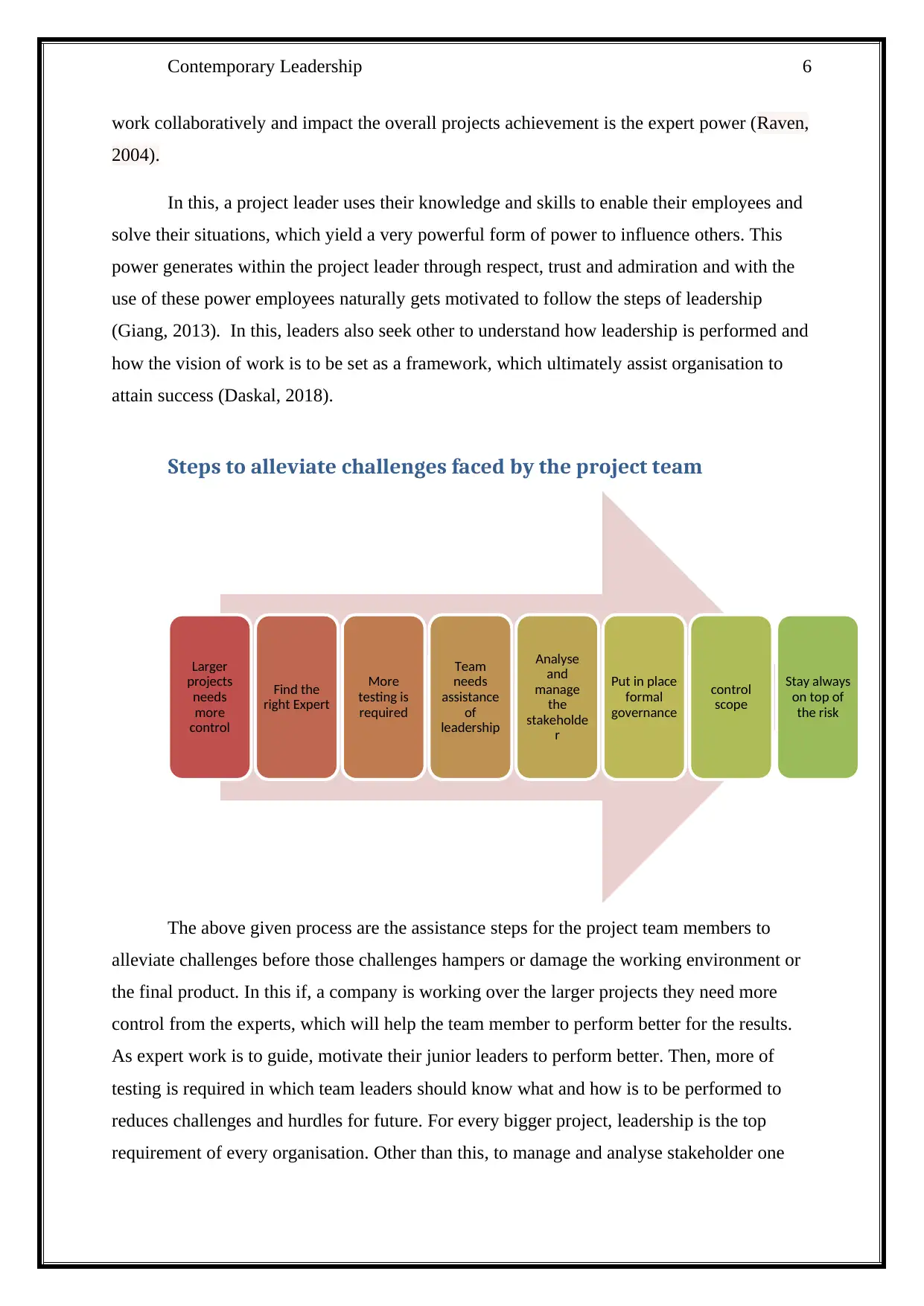
Contemporary Leadership 6
work collaboratively and impact the overall projects achievement is the expert power (Raven,
2004).
In this, a project leader uses their knowledge and skills to enable their employees and
solve their situations, which yield a very powerful form of power to influence others. This
power generates within the project leader through respect, trust and admiration and with the
use of these power employees naturally gets motivated to follow the steps of leadership
(Giang, 2013). In this, leaders also seek other to understand how leadership is performed and
how the vision of work is to be set as a framework, which ultimately assist organisation to
attain success (Daskal, 2018).
Steps to alleviate challenges faced by the project team
The above given process are the assistance steps for the project team members to
alleviate challenges before those challenges hampers or damage the working environment or
the final product. In this if, a company is working over the larger projects they need more
control from the experts, which will help the team member to perform better for the results.
As expert work is to guide, motivate their junior leaders to perform better. Then, more of
testing is required in which team leaders should know what and how is to be performed to
reduces challenges and hurdles for future. For every bigger project, leadership is the top
requirement of every organisation. Other than this, to manage and analyse stakeholder one
Larger
projects
needs
more
control
Find the
right Expert
More
testing is
required
Team
needs
assistance
of
leadership
Analyse
and
manage
the
stakeholde
r
Put in place
formal
governance
control
scope
Stay always
on top of
the risk
work collaboratively and impact the overall projects achievement is the expert power (Raven,
2004).
In this, a project leader uses their knowledge and skills to enable their employees and
solve their situations, which yield a very powerful form of power to influence others. This
power generates within the project leader through respect, trust and admiration and with the
use of these power employees naturally gets motivated to follow the steps of leadership
(Giang, 2013). In this, leaders also seek other to understand how leadership is performed and
how the vision of work is to be set as a framework, which ultimately assist organisation to
attain success (Daskal, 2018).
Steps to alleviate challenges faced by the project team
The above given process are the assistance steps for the project team members to
alleviate challenges before those challenges hampers or damage the working environment or
the final product. In this if, a company is working over the larger projects they need more
control from the experts, which will help the team member to perform better for the results.
As expert work is to guide, motivate their junior leaders to perform better. Then, more of
testing is required in which team leaders should know what and how is to be performed to
reduces challenges and hurdles for future. For every bigger project, leadership is the top
requirement of every organisation. Other than this, to manage and analyse stakeholder one
Larger
projects
needs
more
control
Find the
right Expert
More
testing is
required
Team
needs
assistance
of
leadership
Analyse
and
manage
the
stakeholde
r
Put in place
formal
governance
control
scope
Stay always
on top of
the risk
Paraphrase This Document
Need a fresh take? Get an instant paraphrase of this document with our AI Paraphraser
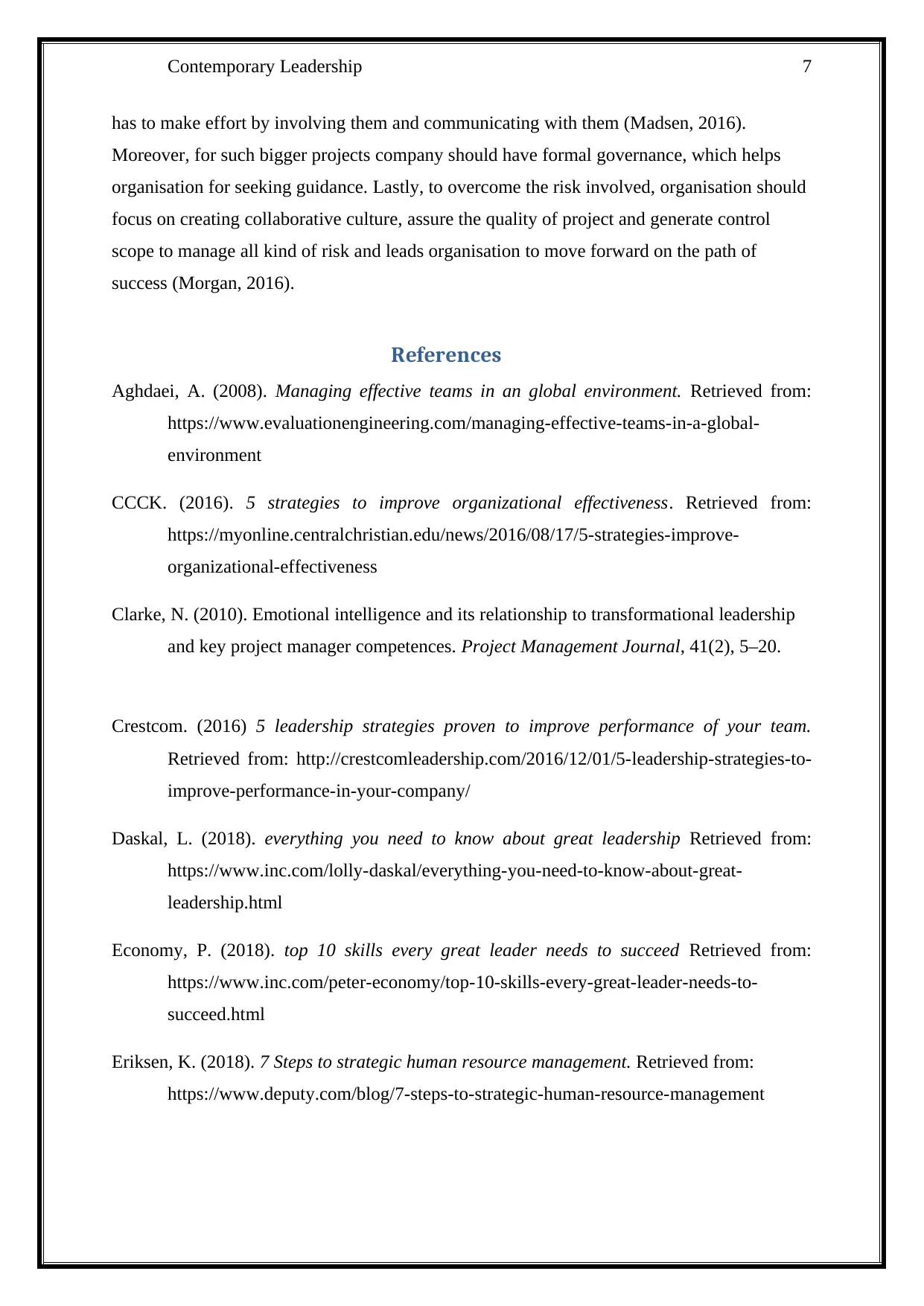
Contemporary Leadership 7
has to make effort by involving them and communicating with them (Madsen, 2016).
Moreover, for such bigger projects company should have formal governance, which helps
organisation for seeking guidance. Lastly, to overcome the risk involved, organisation should
focus on creating collaborative culture, assure the quality of project and generate control
scope to manage all kind of risk and leads organisation to move forward on the path of
success (Morgan, 2016).
References
Aghdaei, A. (2008). Managing effective teams in an global environment. Retrieved from:
https://www.evaluationengineering.com/managing-effective-teams-in-a-global-
environment
CCCK. (2016). 5 strategies to improve organizational effectiveness. Retrieved from:
https://myonline.centralchristian.edu/news/2016/08/17/5-strategies-improve-
organizational-effectiveness
Clarke, N. (2010). Emotional intelligence and its relationship to transformational leadership
and key project manager competences. Project Management Journal, 41(2), 5–20.
Crestcom. (2016) 5 leadership strategies proven to improve performance of your team.
Retrieved from: http://crestcomleadership.com/2016/12/01/5-leadership-strategies-to-
improve-performance-in-your-company/
Daskal, L. (2018). everything you need to know about great leadership Retrieved from:
https://www.inc.com/lolly-daskal/everything-you-need-to-know-about-great-
leadership.html
Economy, P. (2018). top 10 skills every great leader needs to succeed Retrieved from:
https://www.inc.com/peter-economy/top-10-skills-every-great-leader-needs-to-
succeed.html
Eriksen, K. (2018). 7 Steps to strategic human resource management. Retrieved from:
https://www.deputy.com/blog/7-steps-to-strategic-human-resource-management
has to make effort by involving them and communicating with them (Madsen, 2016).
Moreover, for such bigger projects company should have formal governance, which helps
organisation for seeking guidance. Lastly, to overcome the risk involved, organisation should
focus on creating collaborative culture, assure the quality of project and generate control
scope to manage all kind of risk and leads organisation to move forward on the path of
success (Morgan, 2016).
References
Aghdaei, A. (2008). Managing effective teams in an global environment. Retrieved from:
https://www.evaluationengineering.com/managing-effective-teams-in-a-global-
environment
CCCK. (2016). 5 strategies to improve organizational effectiveness. Retrieved from:
https://myonline.centralchristian.edu/news/2016/08/17/5-strategies-improve-
organizational-effectiveness
Clarke, N. (2010). Emotional intelligence and its relationship to transformational leadership
and key project manager competences. Project Management Journal, 41(2), 5–20.
Crestcom. (2016) 5 leadership strategies proven to improve performance of your team.
Retrieved from: http://crestcomleadership.com/2016/12/01/5-leadership-strategies-to-
improve-performance-in-your-company/
Daskal, L. (2018). everything you need to know about great leadership Retrieved from:
https://www.inc.com/lolly-daskal/everything-you-need-to-know-about-great-
leadership.html
Economy, P. (2018). top 10 skills every great leader needs to succeed Retrieved from:
https://www.inc.com/peter-economy/top-10-skills-every-great-leader-needs-to-
succeed.html
Eriksen, K. (2018). 7 Steps to strategic human resource management. Retrieved from:
https://www.deputy.com/blog/7-steps-to-strategic-human-resource-management
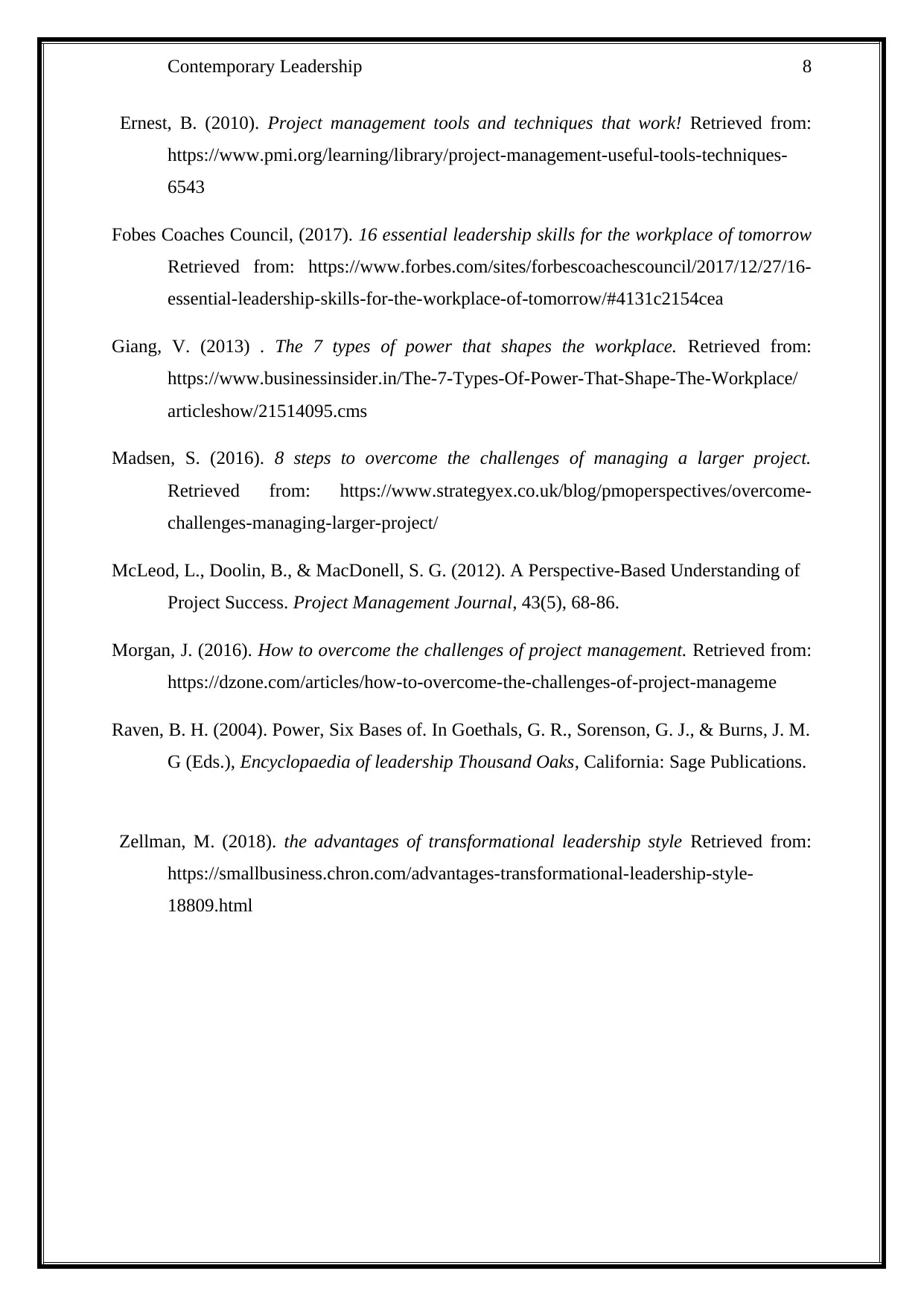
Contemporary Leadership 8
Ernest, B. (2010). Project management tools and techniques that work! Retrieved from:
https://www.pmi.org/learning/library/project-management-useful-tools-techniques-
6543
Fobes Coaches Council, (2017). 16 essential leadership skills for the workplace of tomorrow
Retrieved from: https://www.forbes.com/sites/forbescoachescouncil/2017/12/27/16-
essential-leadership-skills-for-the-workplace-of-tomorrow/#4131c2154cea
Giang, V. (2013) . The 7 types of power that shapes the workplace. Retrieved from:
https://www.businessinsider.in/The-7-Types-Of-Power-That-Shape-The-Workplace/
articleshow/21514095.cms
Madsen, S. (2016). 8 steps to overcome the challenges of managing a larger project.
Retrieved from: https://www.strategyex.co.uk/blog/pmoperspectives/overcome-
challenges-managing-larger-project/
McLeod, L., Doolin, B., & MacDonell, S. G. (2012). A Perspective-Based Understanding of
Project Success. Project Management Journal, 43(5), 68-86.
Morgan, J. (2016). How to overcome the challenges of project management. Retrieved from:
https://dzone.com/articles/how-to-overcome-the-challenges-of-project-manageme
Raven, B. H. (2004). Power, Six Bases of. In Goethals, G. R., Sorenson, G. J., & Burns, J. M.
G (Eds.), Encyclopaedia of leadership Thousand Oaks, California: Sage Publications.
Zellman, M. (2018). the advantages of transformational leadership style Retrieved from:
https://smallbusiness.chron.com/advantages-transformational-leadership-style-
18809.html
Ernest, B. (2010). Project management tools and techniques that work! Retrieved from:
https://www.pmi.org/learning/library/project-management-useful-tools-techniques-
6543
Fobes Coaches Council, (2017). 16 essential leadership skills for the workplace of tomorrow
Retrieved from: https://www.forbes.com/sites/forbescoachescouncil/2017/12/27/16-
essential-leadership-skills-for-the-workplace-of-tomorrow/#4131c2154cea
Giang, V. (2013) . The 7 types of power that shapes the workplace. Retrieved from:
https://www.businessinsider.in/The-7-Types-Of-Power-That-Shape-The-Workplace/
articleshow/21514095.cms
Madsen, S. (2016). 8 steps to overcome the challenges of managing a larger project.
Retrieved from: https://www.strategyex.co.uk/blog/pmoperspectives/overcome-
challenges-managing-larger-project/
McLeod, L., Doolin, B., & MacDonell, S. G. (2012). A Perspective-Based Understanding of
Project Success. Project Management Journal, 43(5), 68-86.
Morgan, J. (2016). How to overcome the challenges of project management. Retrieved from:
https://dzone.com/articles/how-to-overcome-the-challenges-of-project-manageme
Raven, B. H. (2004). Power, Six Bases of. In Goethals, G. R., Sorenson, G. J., & Burns, J. M.
G (Eds.), Encyclopaedia of leadership Thousand Oaks, California: Sage Publications.
Zellman, M. (2018). the advantages of transformational leadership style Retrieved from:
https://smallbusiness.chron.com/advantages-transformational-leadership-style-
18809.html
⊘ This is a preview!⊘
Do you want full access?
Subscribe today to unlock all pages.

Trusted by 1+ million students worldwide
1 out of 9
Related Documents
Your All-in-One AI-Powered Toolkit for Academic Success.
+13062052269
info@desklib.com
Available 24*7 on WhatsApp / Email
![[object Object]](/_next/static/media/star-bottom.7253800d.svg)
Unlock your academic potential
Copyright © 2020–2025 A2Z Services. All Rights Reserved. Developed and managed by ZUCOL.




